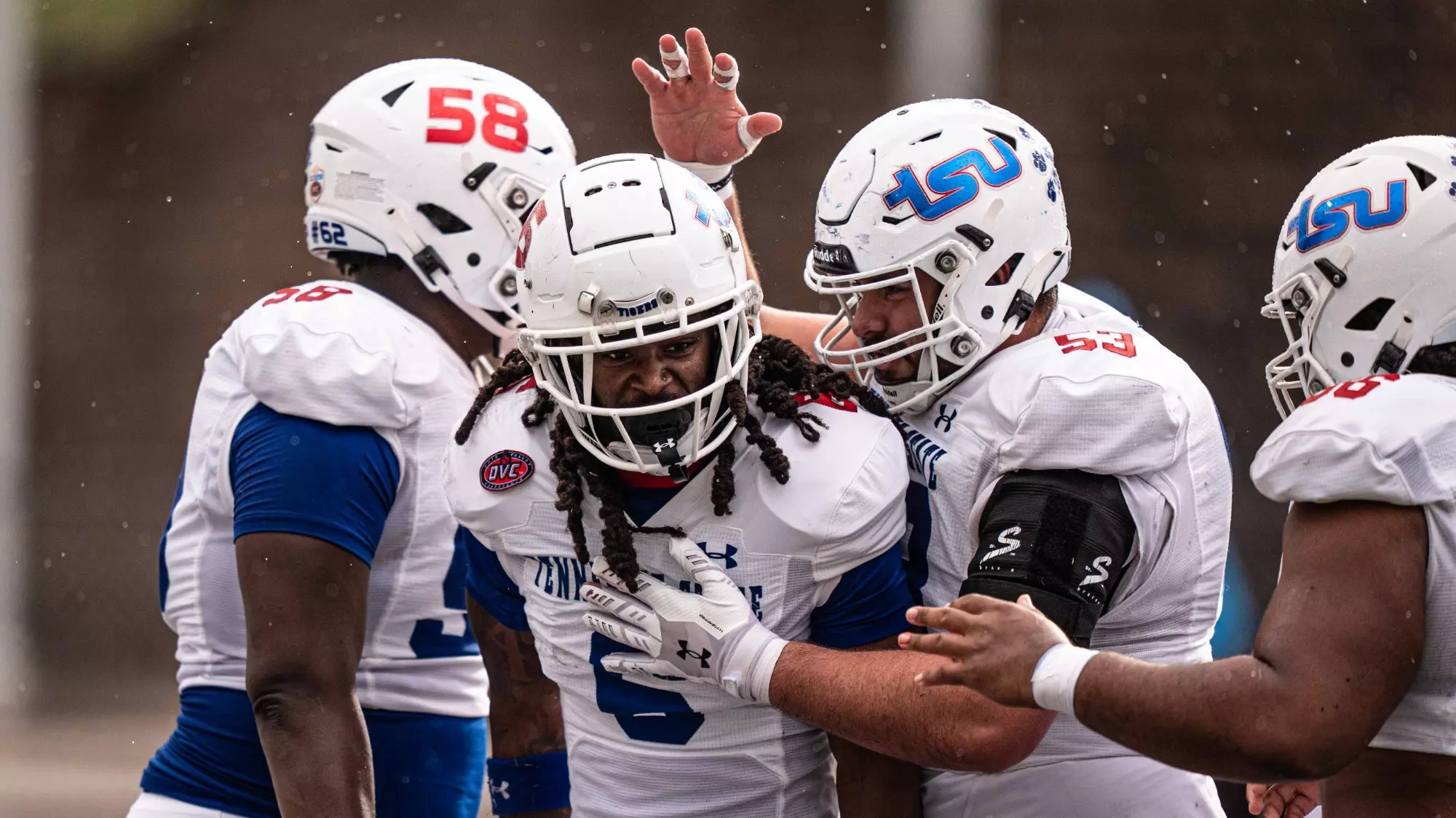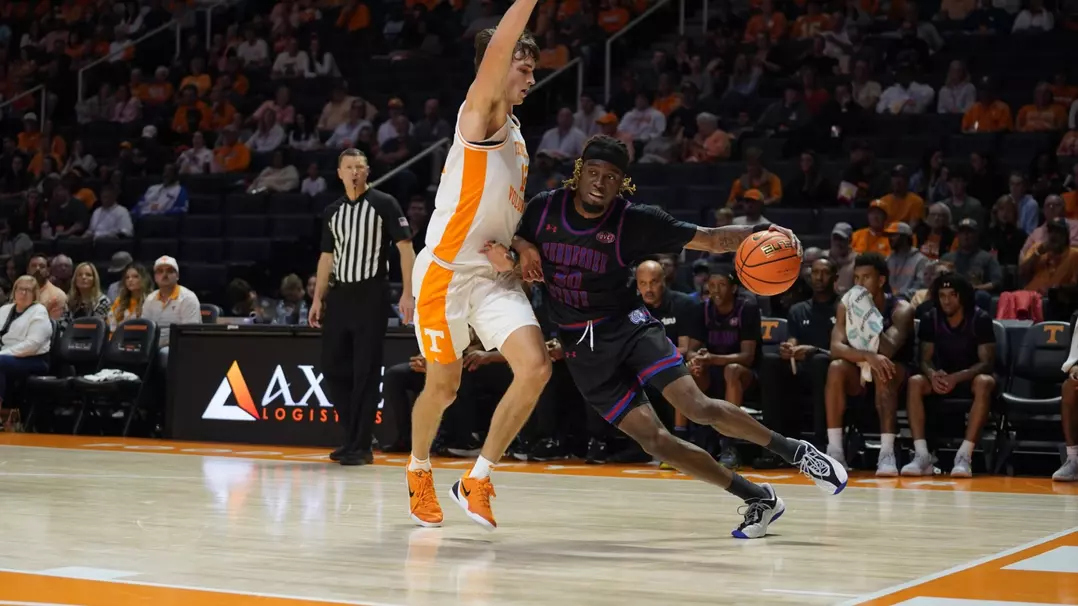Since Eddie George, former NFL star and current head coach at Tennessee State University, made his comment about the Ohio Valley Conference (OVC) being a “dying conference” in 2021, the OVC has indeed seen a notable shift in membership. As of 2023, the OVC has lost several schools, and his comment has proven to be somewhat prophetic in highlighting the conference’s struggles with realignment and stability. Here’s a breakdown of the schools that have left or are set to leave the OVC since that remark:
1. Tennessee Tech (2026) – Tennessee Tech announced in 2021 that it would leave the OVC for the Southern Conference (SoCon) starting in 2026, marking a significant blow to the OVC, as Tennessee Tech had been one of its more established programs, particularly in football and basketball.
2. Murray State (2022) – Murray State University, a key member of the OVC, decided to leave for the Missouri Valley Conference (MVC) in 2022. This was another significant departure, as Murray State had been competitive across several sports, particularly basketball.
3. Austin Peay (2022) – Austin Peay State University, one of the OVC’s prominent athletic programs, announced its departure in 2022 to join the ASUN Conference. This move further reduced the strength and geographic footprint of the OVC.
4. Eastern Kentucky (2021) – Eastern Kentucky University also moved to the ASUN Conference in 2021, following a similar trajectory as Austin Peay, contributing to the OVC’s ongoing challenges.
These four schools (Tennessee Tech, Murray State, Austin Peay, and Eastern Kentucky) have either already left or have plans to leave the OVC, significantly reducing the conference’s membership and competitive depth.
This wave of departures follows a broader trend of conference realignment across college athletics, as schools seek to join conferences that offer better competitive opportunities, more exposure, and greater financial stability. For the OVC, these losses have underscored the growing challenges it faces in maintaining its relevance and competitiveness in an era of realignment and shifting media landscapes.
While the OVC has expanded with former NCAA Division II members Lindenwood (football, 2022) and Southern Indiana(basketball, 2022) as well as NCAA Division I member Arkansas Little Rock (basketball, 2022), Eddie George’s comment was a pointed critique, the reality has unfolded with schools from the OVC seeking new homes in larger, more prominent conferences, which ultimately leaves the OVC with fewer member institutions, leading to questions about its future viability.
Tennessee Tech Announces Departure from OVC
Now Tennessee Tech’s recently announced decision to leave the Ohio Valley Conference (OVC) for the Southern Conference (SoCon) in 2026 presents both an exciting opportunity for the Golden Eagles and a significant challenge for the OVC. The departure of a prominent member like Tennessee Tech weakens the OVC’s competitive and financial standing, as it loses one of its established programs. Tennessee Tech has historically been a competitive force in sports like football, basketball, and baseball, and its exit from the OVC creates a gap in terms of both athletic talent and fan engagement. This shift will require the OVC to reassess its membership strategy and potentially seek new schools to maintain its viability, particularly before other programs leave the conference. The departure of Tennessee Tech also signals a broader trend of conference realignment that could continue to reshape the landscape of college athletics, as schools seek more lucrative and competitive environments. For the OVC, it will be important to recover from the loss of a key member while maintaining a strong brand and ensuring that its remaining members remain financially stable and competitive.
Tennessee State’s Athletic Challenges
The challenge intensifies the challenges Tennessee State athletics program has as a member of the OVC, as its athletics program and the conference face an even greater reliance on its strategic alliance with the Big South Conference in the sport of football.
The Big South-OVC partnership was formed to help both leagues strengthen their positioning and maintain athletic relevance in a shifting Football Championship Subdivision (FCS) conference churning landscape. However, Tennessee Tech’s departure could weaken the alliance, as the OVC’s overall competitiveness and visibility could be further diminished without its historically strong programs. The Big South-OVC alliance was designed to enhance scheduling, increase post-season opportunities, and improve financial stability through shared resources, but with the loss of Tennessee Tech, the OVC may need to re-evaluate the long-term viability of this partnership. Furthermore, other schools, such as Tennessee State, within the OVC could now look to join more competitive or financially advantageous conferences, potentially further eroding the strength of the alliance.
There seems to be ongoing discussions by many in the HBCU social media eco-system about Tennessee State potentially joining the Southwestern Athletic Conference (SWAC). With the announcement of Tennessee Tech leaving the OVC and joining the Southern Conference (SoCon) in 2026, this creates another significant development in the landscape of intercollegiate athletics and conference realignment.
Tennessee State, the only historically Black university (HBCU) in the Ohio Valley Conference (OVC), over the last two and half decades has long been considered a potential target for SWAC expansion due to its strong athletic programs, particularly in football, and its geographical location, particularly due to it being regionally aligned with many of the SWAC eastern division members.
Tennessee State has faced several SWAC members in HBCU Classic (i.e. Southern Heritage Classic and John Merritt Classic) games over the years. While, Tennessee State and Jackson State no longer face each other in the Southern Heritage Classic, back in February, Tennessee State University and Alabama A&M University announced a four-year football series, dubbed the “Legacy Series,” beginning in the 2025 season. The series will alternate between Nashville and Huntsville, with the first game on September 13, 2025, at Nissan Stadium in Nashville. The teams will then play in Huntsville on September 12, 2026, followed by games in Nashville on September 11, 2027, and Huntsville on September 16, 2028.
What has changed in the NCAA Landscape?
The NCAA vs. House settlement and the subsequent changes in Name, Image, and Likeness (NIL) rights have had profound implications across all divisions of college athletics, but their impact within Historically Black Colleges and Universities (HBCUs), particularly in Division I (DI) programs, has been especially noteworthy. For years, athletes at HBCUs faced significant financial disparities compared to their counterparts at larger, predominantly white institutions. The House settlement, which challenged the NCAA’s restrictive NIL policies, created an environment where HBCU athletes could finally tap into revenue streams such as endorsement deals, social media monetization, and local sponsorships. This was particularly significant for schools that historically lacked the resources to compete in recruiting top-tier talent, giving athletes the ability to profit while still playing for institutions with rich cultural traditions and strong community ties. The shift offered a unique opportunity for HBCU athletes to build their brands, often connecting with local and regional sponsors who valued their influence in ways that went beyond the traditional sports market.
Despite these opportunities, the rapid evolution of NIL has presented both challenges and potential advantages for HBCU DI programs. On one hand, athletes at HBCUs now can stay closer to their roots while capitalizing on their brands. On the other hand, the financial disparity between HBCUs and larger, wealthier programs remains a significant hurdle. Major universities with more significant media exposure, larger fanbases, and well-established corporate relationships are often in a better position to attract higher-profile NIL deals for their athletes. This could leave athletes at HBCUs at a disadvantage if they cannot secure similar opportunities. However, HBCUs also have the advantages of stronger connections to local communities and alumni networks, which can help close the gap. Regardless, the evolving NIL landscape presents a delicate balancing act for HBCU DI programs: leveraging new revenue streams to remain competitive while ensuring they maintain their cultural significance and identity in the face of growing commercialization in college sports.
The NCAA Division I FCS 12-Game Regular Season
The NCAA Division I Council approved a move to a permanent 12-game regular season for the Football Championship Subdivision (FCS) starting in the 2026 academic season. The NCAA’s announcement of a 12-game season for FCS marks a pivotal shift in the landscape of college football at the FCS level. This change was made in response to the growing demands from both coaches and athletic directors for more flexibility in scheduling, increased revenue opportunities, and better alignment with FBS programs, which already operate on a 12-game schedule. The 12-game season provides FCS schools with the chance to schedule an additional game each season, including potential non-conference matchups with FCS opponents or expansion of the conference schedule from an eight-game slate to nine games, which can increase revenues, marquee matchups, rivalry games, visibility, fan engagement, and television ratings. The ability to schedule an additional game also creates new revenue opportunities, particularly from ticket sales, concessions, and media rights, which are crucial for many programs operating with limited resources.
For the SWAC, the extra game could lead to more competitive opportunities and potentially more national attention. Teams can now schedule more marquee matchups, creating exciting rivalry games that could attract larger audiences. Additionally, the extended schedule provides teams with greater flexibility in arranging non-conference games, which could be used to bolster strength-of-schedule metrics for playoff positioning.
What is Happening in the SWAC?
The Southwestern Athletic Conference (SWAC) expansion in 2020, which saw Florida A&M University (FAMU) and Bethune-Cookman University (BCU) join the conference, was a significant move in the world of HBCU athletics. This expansion not only bolstered the conference’s football and basketball programs but also enhanced its visibility and competitive stature within college sports. For FAMU, a historic and high-profile HBCU, the decision to leave the Mid-Eastern Athletic Conference (MEAC) and join the SWAC was rooted in both athletic and financial considerations. The move allowed FAMU to compete in a more competitive environment with schools that have higher-profile football programs, such as Jackson State, Grambling State, and Southern, regionally matchups with Alabama State and Alabama, and it provided the university with better opportunities for media exposure and recruitment.
The addition of FAMU, with its large fan base, strong athletic history, and academic reputation, injected a new level of excitement into the SWAC and created opportunities for new regional rivalries, particularly with schools in the Southern states. Bethune-Cookman’s decision to join the SWAC alongside FAMU was part of a broader strategy to strengthen the athletic conference and increase its competitive balance, particularly in football. BCU’s decision to leave the MEAC and join the SWAC brought its own set of advantages, including greater potential for increased revenue through more lucrative television deals, as the SWAC had been making significant strides in enhancing its media rights and visibility, especially with the rise of the “HBCU Movement.”
For the SWAC, the addition of these two historically significant programs aligned with its goal of growth and increasing national relevance, particularly as college athletics continue to evolve and seek more lucrative media deals. The dual expansion of FAMU and BCU also helped solidify the SWAC’s position as the dominant football FCS conference, further increasing its appeal to recruits and national media. These moves not only strengthened the football and basketball brands of the SWAC but also set the stage for future growth, with the possibility of even more schools considering similar shifts to boost their own athletic and financial prospects.
SWAC TV Announced
The SWAC (Southwestern Athletic Conference) TV announcement has the potential to provide long-term financial benefits for the conference and its member institutions. SWAC TV includes the broadcasting of football, basketball, and other sports on national and regional platforms, and will result in increased exposure and visibility for SWAC programs. The conference announced that 43 football games will be broadcast on SWAC TV. For the schools within the conference, this deal represents a game-changing opportunity to showcase their athletic talent and grow their fan bases. With more games accessible to wider audiences, the SWAC schools stand to attract more viewers, which can translate into increased ticket sales, merchandise revenue, additional league corporate partnerships, and larger sponsorship deals. The long-term financial windfall could be realized as media networks seek to capitalize on the growing interest in HBCU sports, potentially leading to higher advertising revenues for the conference as its audience base expands.
Additionally, the financial benefits go beyond just immediate revenue from broadcasting deals. The SWAC TV announcement could enhance the conference’s ability to attract higher-profile athletes, particularly with the increased exposure making its programs more competitive in recruiting. Over time, this can lead to improved athletic performance, which can in turn drive more significant media attention and brand partnerships. Moreover, this deal is likely to create new opportunities for alumni engagement as brands view the increased value of partnering with schools that now have an increased national multimedia platform. Ultimately, the financial effects could reverberate throughout the SWAC for years to come, creating a more sustainable revenue model that empowers member institutions to reinvest in their athletic departments, improve facilities, and provide better support for student-athletes. This increased financial independence could also allow for further academic and programmatic investments, ensuring that the SWAC remains competitive both on and off the field.
SWAC Expansion Talk Continues in the Social Media Echo Chamber
Many HBCU social media influencers, content creators, and fans often suggest the move could benefit both Tennessee State and the SWAC, as it would allow Tennessee State to join a conference with a significant national profile and more competitive opportunities in sports like football, basketball, and track. For Tennessee State, joining the SWAC could mean increased visibility, better recruiting opportunities, and potentially larger media rights deals as part of a broader conference network that includes programs like Jackson State, Southern, Florida A&M, and Prairie View A&M, which have seen significant growth in recent years.
For the SWAC, the addition of Tennessee State would expand the conference’s footprint into a new geographic area, the state of Tennessee, and more specifically the media market of Nashville. This would open doors to greater fan engagement and regional rivalries that could increase attendance at games and boost television ratings, further rising the conference’s revenue growth, especially as it capitalizes on its new media deals and most recent SWAC TV announcements. From an academic perspective, it would increase the number of Carnegie Classification member institutions to six (i.e. Florida A&M, Jackson State, Prairie View A&M, Southern, and Texas Southern).
However, the potential move also brings challenges. The SWAC would need to ensure that adding Tennessee State would not upset the sport of football’s competitive balance of the conference, particularly in football, where schools like Jackson State and Florida A&M have recently dominated the conference since the most recent expansion. While the Tennessee State men’s basketball program has been strong over the last decade, the softball program has recently improved. The women’s program has not been competitive, and the Tigers do not offer baseball. In addition, if there is no expansion of a 14-member institution it would create an unbalanced conference divisional alignment.
The expansion talks, therefore, represent both a promising opportunity for Tennessee State and a strategic decision for the SWAC as it continues to grow its influence in the world of college athletics, particularly at the FCS level. There would be excitement among various parties with Tennessee State Tigers athletics program announcing their intentions to join the SWAC, the question must be considered; with the current financial momentum (i.e. highest distribution to conference members on record) does Tennessee State provide the additional annual value to increase the overall revenue metrics to justify earning the presidents and chancellors support?
Why would it be beneficial for the Tennessee State to seek admittance into the SWAC
There are six compelling reasons why it could be more beneficial for the Tennessee State Tigers to join the Southwestern Athletic Conference (SWAC) rather than staying as a member of the Ohio Valley Conference (OVC).
1. Increased Exposure and National Recognition:
The SWAC has significantly grown in visibility in recent years, largely due to the high-profile presence of schools like Jackson State, Southern, and Florida A&M, particularly with the rise of media deals and the growing “HBCU Movement.” For Tennessee State, joining the SWAC would mean aligning with a conference that has better television exposure, increased multimedia coverage, and higher-profile games. The SWAC’s broadcast deals, including partnerships with ESPN, HBCU Goand other networks, have elevated its national profile, which benefits the Tigers’ brand. Tennessee State would likely see increased visibility, helping recruit top-tier athletes, increasing academic high school student recruiting opportunities in major urban cities, and improving its overall program’s reputation.
2. Stronger Athletic Competition and Rivalries:
The SWAC is considered one of the top football conferences in FCS and joining it would place Tennessee State in a more competitive environment. In football, the Tigers would face schools like Jackson State, Southern, and Florida A&M, which have garnered significant attention. The level of competition in the SWAC is a step up from the OVC in the latest iteration, which could help Tennessee State’s football program improve. Additionally, joining the SWAC would allow the Tigers to participate in exciting regional rivalries with schools such as Alabama State, Alcorn State, and Alabama State, which could drive fan and social media engagement, create more excitement around the program, and lead to more revenue from ticket sales and sponsorships.
3. Increased Recruiting Opportunities:
With a larger media footprint, stronger competition, and more notable matchups, recruiting at Tennessee State would likely take a significant leap. The Tigers would be able to attract more high-profile recruits who are drawn to the higher visibility of SWAC schools and the potential to play on bigger platforms. The SWAC’s emphasis on community, culture, and high-profile athletes has attracted attention from both top recruits and national media. Tennessee State could benefit from these trends and strengthen its roster in ways that might be more challenging in the smaller, less media-centric OVC.
4. Financial Incentives and Conference Stability:
The financial upside of joining the SWAC, especially with its media deals, would be significant for Tennessee State. The SWAC is in a strong position to continue to negotiate better television and sponsorship contracts, and as the conference continues to grow, those revenues will be distributed among the member schools. The OVC, on the other hand, has faced challenges in recent years due to realignment, losing schools like Tennessee Tech, and the financial disparity between the two conferences might be more pronounced in the long run.
With the SWAC’s growth trajectory and more lucrative media deals, Tennessee State would benefit financially, which would help fund its athletic programs and improve facilities and resources for college athletes, particularly in the current collegiate Name, Image, and Likeness (NIL) driven landscape.
As a conference, the SWAC member institutions have opted into the NCAA vs. House settlement agreement. Which means the current member institutions have agreed to abide by its terms, which include provisions for backpay damages for past athletes, a framework for direct compensation to current athletes, and new regulations around NIL deals. Tennessee State did not opt in.
5. Cultural and Institutional Alignment:
As a historically Black university (HBCU), Tennessee State shares a cultural affinity with the schools in the SWAC. Being a part of a conference that is deeply rooted in HBCU culture could foster a stronger sense of community, school spirit, and identity (i.e. increasing game-day attendance). The SWAC’s commitment to promoting the legacy and history of HBCUs aligns with Tennessee State’s mission and heritage. This cultural fit could help Tennessee State maintain and strengthen its legacy as one of the premier HBCUs in the nation.
6. Potential for Long-Term Growth:
Finally, the move to the SWAC could position Tennessee State for long-term growth in both athletic and academic performance. The increased resources, exposure, and competition would likely have a positive ripple effect on all sports programs at Tennessee State University, from football to basketball and track. In addition, the broader cultural and academic resources within the SWAC might provide Tennessee State with new opportunities for institutional growth, community partnerships, and recruitment of high-quality students, not just athletes.
In summary, joining the SWAC would provide Tennessee State with more exposure, stronger competition, financial incentives, and alignment with institutions that share its cultural heritage. This could help elevate the Tigers’ athletic programs and position the university for long-term success in the ever-changing landscape of college athletics.
Tennessee State on the Move!
The fall slate includes five home games and nine games against HBCU opponents. The conference slate includes nine contests as a new member of the Southwestern Athletic Conference (SWAC). Based on the NCAA’s announcement of a 12-game season for FCS, the SWAC has moved to a nine-game conference format as the conference has grown to 14-members with the admittance of Tennessee State University and Clark-Atlanta University (as the begin the transition from NCAA Division II to the NCAA Division I FCS level and would be the SWAC’s seventh R2 Carnegie Classification member institution)for 2026 season.
The nine-game SWAC scheduling arrangement will feature six games from intra-divisional opponents, three inter-divisional opponents. One of the inter-divisional opponents will be designated as a fixed opponent, while the remaining two games will rotate every two years among the six remaining inter-divisional opponents. This guarantees every conference member will play against each other at least twice every six years.
| SWAC | ||
| Eastern Division | Western Division | |
| Alabama A&M | Alcorn State | |
| Alabama State | Grambling | |
| Bethune-Cookman | Mississippi Valley State | |
| Clark-Atlanta | Prairie View A&M | |
| Florida A&M | Southern | |
| Jackson State | Texas Southern | |
| Tennessee State | Arkansas at Pine Bluff |
Fixed Opponent
| Florida A&M | ↔ | Southern |
| Jackson State | ↔ | Alcorn State |
| Clark-Atlanta | ↔ | Texas Southern |
| Tennessee State | ↔ | Grambling State |
| Alabama A&M | ↔ | Prairie View A&M |
| Alabama State | ↔ | Arkansas at Pine Bluff |
| Bethune-Cookman | ↔ | Mississippi Valley State |
Tennessee State
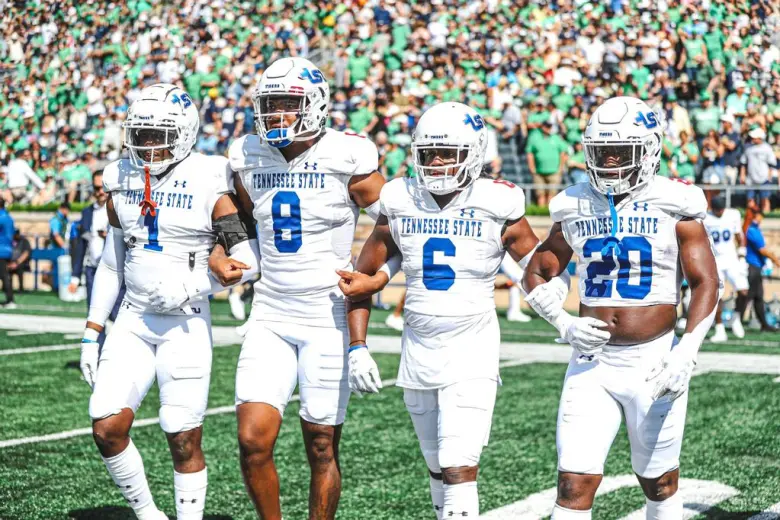
Last season Tennessee State’s head football coach aired his frustrations with attendance, or more specifically, the lack thereof, even as the team was during its most successful season in nearly a decade. His comments reignited long-smoldering sentiments on the cause of the lackluster number of eyeballs on TSU games, the prime driver being the conference real estate that Tennessee State currently occupies.
Tennessee State has been a part of the Ohio Valley Conference since 1986, much to the chagrin of a large segment of the fanbase. Fans have been clamoring for the University to depart the OVC for many years, however, the Tennessee State athletic department has steadfastly remained committed to the conference, even in the face of the mass exodus of several schools in recent years which necessitated an association with the Big South for the football fielding institutions in both conferences.
The comments this past season by Tennessee State head coach Eddie George shone the light of scrutiny on the number of eyeballs that see the games as well as the opponents that populate their schedule
In a more perfect football landscape, Tennessee State would be a foundational element of an HBCU conference. Although stylistically, from a football standpoint, TSU would seemingly align closer to that of the Mid-Eastern Athletic Conference (MEAC), geographically speaking the most likely home for the Tigers would be the Southwestern Athletic Conference.
What would a season look like for Tennessee State in the SWAC? In this scenario, the conference also extended its footprint to Atlanta, GA adding to its ranks. Clark-Atlanta’s new gridiron battlefield would be the SWAC East, while Tennessee State enters the fray of the conference’s Western Division.
Here is what a season docket for the Tigers might look like:
Week 0 – August 29
Tennessee State v University of Tennessee
Neyland Stadium
Knoxville, Tennessee

Tennessee State hits the ground running, heading toward Knoxville to take on the Volunteers for surprisingly the first time in the storied history of both programs. The matchup will be TSU’s first against an SEC opponent since taking on Mississippi State in 2021in which the Tigers took a 55-10 thrashing.
How it might happen:
The Tigers put up a fight early on, even taking a 7-0 lead. However, as the teams got deeper into their respective roster via substitutions, the talent gap became rsather apparent. Unfortunately for TSU, the difference in talent proved to be insurmountable, leading to the contest to swing decisively in the Volunteers’ favor and they would go on to win 49-14.
Week 1 – September 5
Tennessee State vs. Texas Southern
Nissan Stadium
Nashville, Tennessee
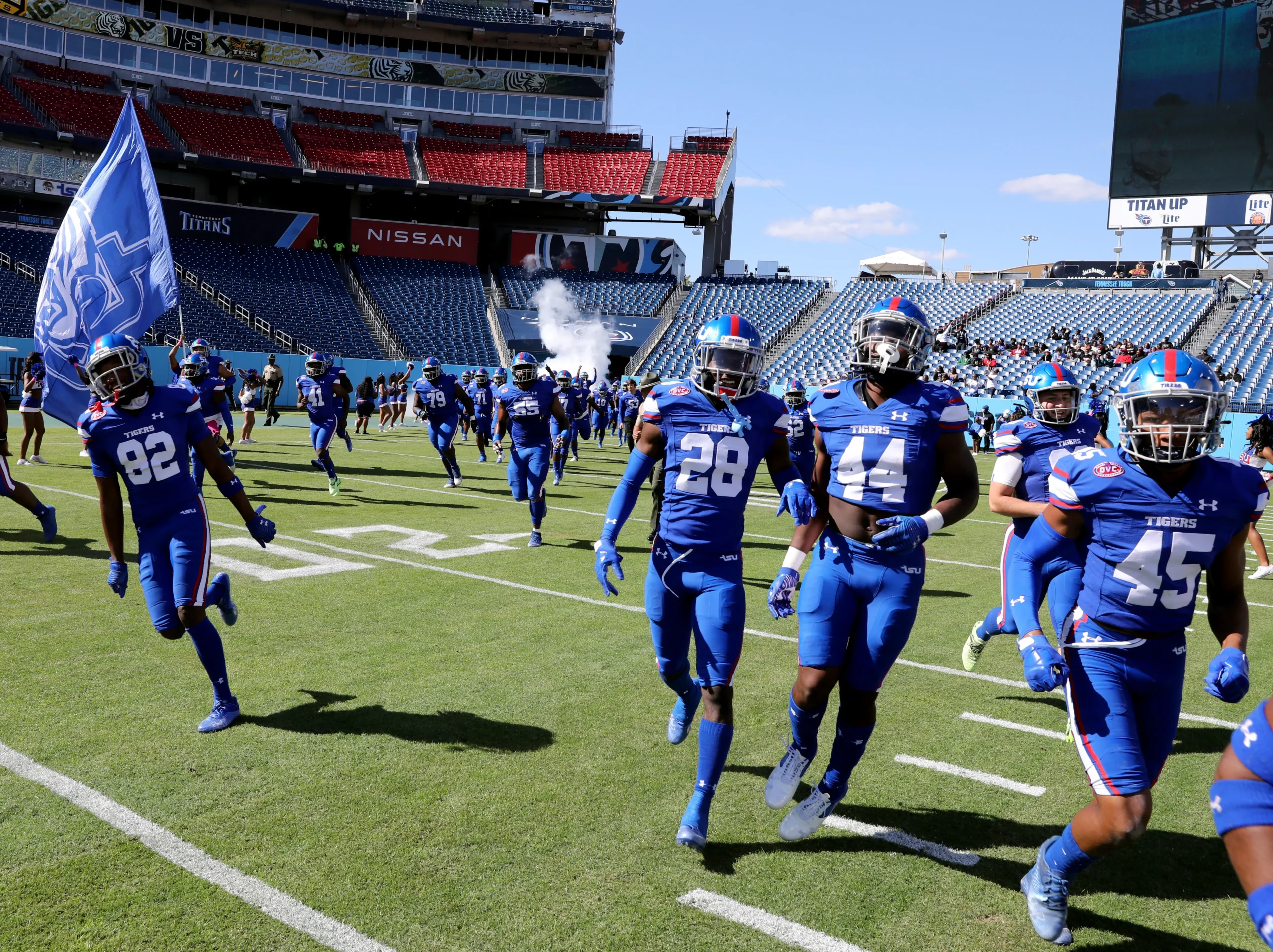
Tennessee State opens up their home schedule in the John Merritt Classic, taking on Texas Southern in a “Battle of the real TSU”. These Tigers have not squared off since 1998, a season-ending home matchup that Tennessee State defeated Texas Southern 28-14.
How might it go:
Buoyed by a home crowd whose appetite for full-time HBCU football is finally being met, Tennessee State emphatically introduces itself to the SWAC with a 31-7 decimation of their fellow Tigers.
Week 2 – September 12
TSU vs. UAPB
Liberty Bowl
Memphis, Tennessee
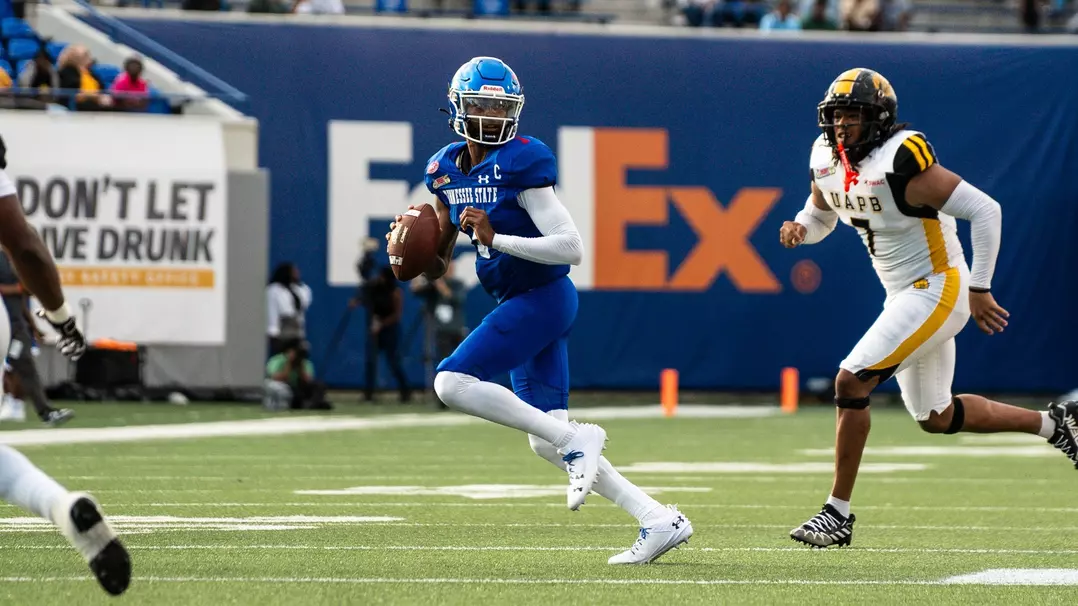
In week two the Tigers will travel to Memphis, Tenn., to take on Arkansas Pine-Bluff in the Southern Heritage Classic. Tennessee welcomed UAPB to the Southern Heritage last season by defeating the Lions 24-14. This matchup now becomes a conference game that will not count in the SWAC standings.
How it might go
UAPB will play hard, but they will not be able to overcome the talent gap, and although it will be a hard-fought contest, Tennessee State will eventually pull away and cruise to a comfortable 34-10 win.
Week 3 – September 19
Tennessee State v Tennessee Tech
Tucker Stadium
Cookeville, Tennessee
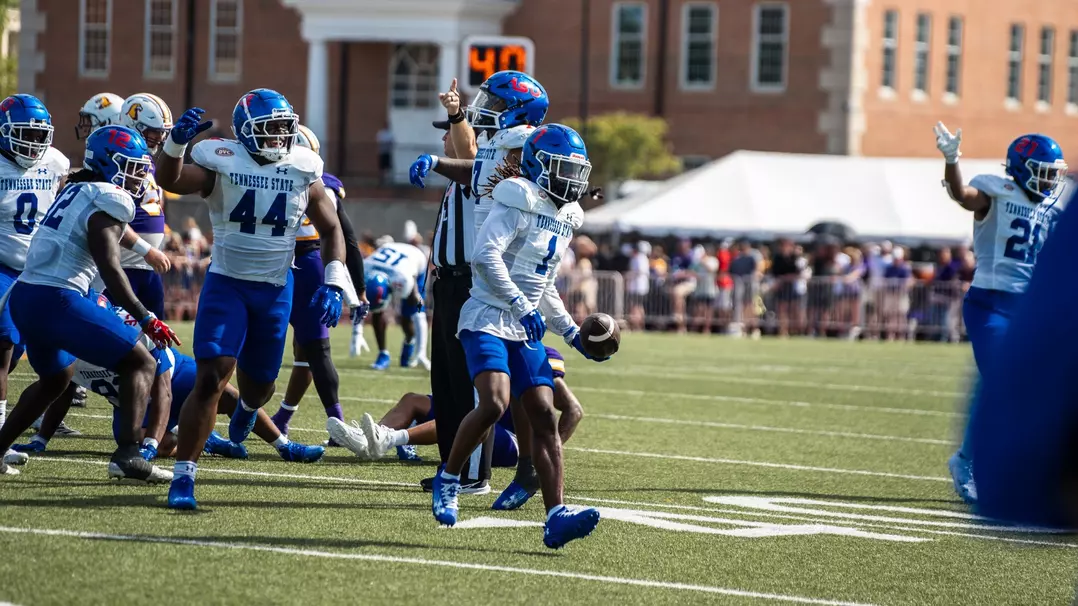
The former conference foes and combatants for the Sgt. York Trophy meets in a non-conference matchup.
The Tigers and Golden Eagles have squared off on 27 occasions and albeit TSU holds a 16-11 series edge, have dropped the last contests, including 24-14 in the team’s last faceoff September 21,2024.
How it might go:
The Golden Eagles’ offense will be a riddle that the Tennessee State defense will have trouble solving, as TTU’s unit was firing on all cylinders for the majority of the contest. However, as their defense had its struggles, the TSU offense had their back, answering each Tech offensive assault with their salvo. A late surge pushes Tennessee State in front for good, claiming victory in the high-scoring affair, 48-40.
Week 4 – September 26
North Carolina Central
Nissan Stadium
Nashville, Tennessee
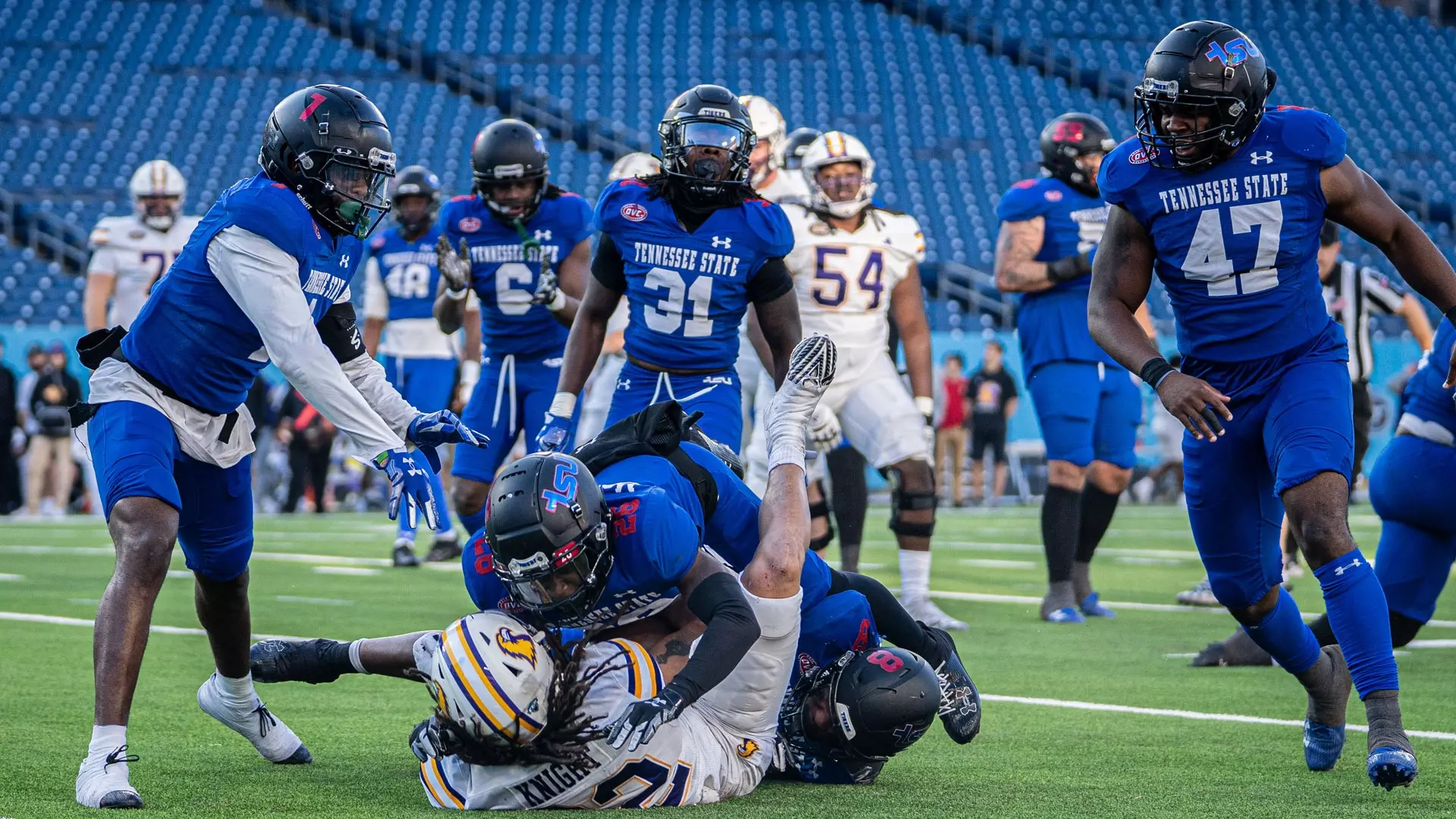
The Eagles of North Carolina Central come to Nashville in this MEAC/SWAC matchup. The two historic programs have not met since November 4,1978 when Tennessee State hammered N.C. Central 41-7 in Capitol Classic in Washington D.C.
How it might happen:
The Eagles will manage to impose their will and largely win the battle in the trenches, particularly on offense. Behind their offensive line, NCCU will serve TSU a healthy dose of their run game, which not only allows them to control the clock, but also keeps the Tennessee State offense largely spectators. Possessing the football for a whopping 36 minutes, the Eagles will grind out a 26-14 victory.
Week 5 – October 3
UT Martin
Nissan Stadium
Nashville, Tennessee

Week 5 sees a familiar foe heading to Nashville in the form of the Skyhawks of UT Martin. Along with Tennessee Tech and TSU, the schools battled for the Sgt. York Trophy, which went to the winner of the triangular series between the then three OVC schools located within the State of Tennessee. Martin last took the trophy in 2023, while Tennessee State hasn’t claimed the hardware since 2013. Tennessee State holds an 18-16 series edge over UT Martin, dating back to their first meeting in 1976, but has lost the last four matchups.
How it might happen:
Unlike in their last meeting, Tennessee State will do Martin the favor of sporting them a 21-0 first quarter lead. Without that three-touchdown springboard, the game was a hotly contested, back and forth affair, with neither team able to wrest control of the game from the other.
A big punt returns in the later stage of the fourth quarter set the TSU offense up deep on UT Martin territory. The Tigers took advantage of the excellent field position, turning into the go-ahead touchdown. The Skyhawks’ potential game-winning drive was snuffed out by the TSU defense, preserving the Tennessee State victory, 34-28.
Week 6 – October 10
TSU at Clark-Atlanta
CAU Panther Stadium
Atlanta, Georgia
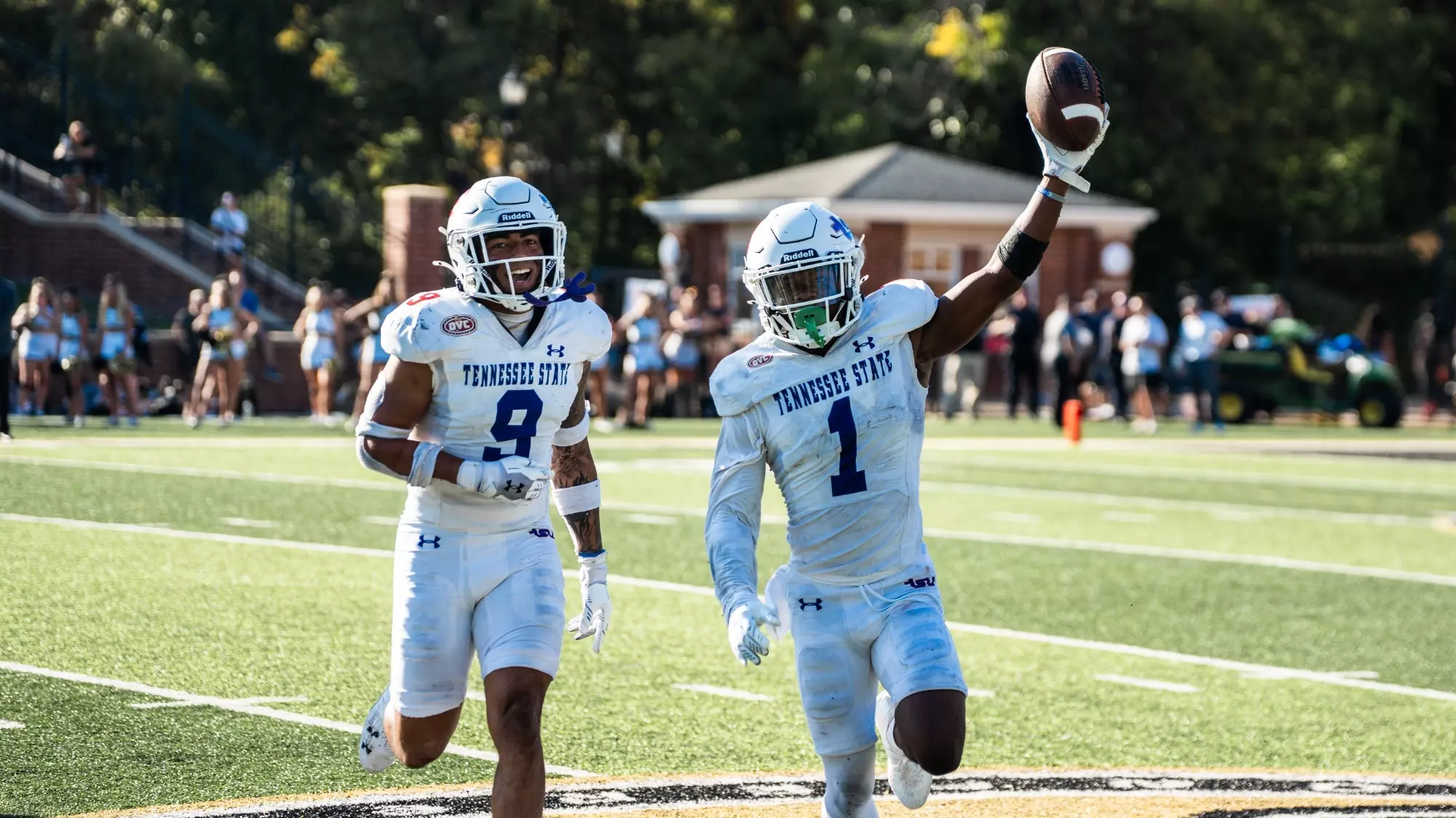
TSU will stay on the road for week six as they will travel to Atlanta, Ga., to take on Clark Atlanta on October 7. The Panthers are transitioning from the NCAA Division II level as the SWAC 14th member. 2023 will be CAU’s last year as a Division II program, as they are set to make the jump to the FCS in 2024. The Tigers and Panthers have not met since 1946 when Tennessee State defeated the then Clark College.
How it might go:
Clark-Atlanta may be reconsidering their decision to join the SWAC, after suffering a 49-7 drubbing at the hands of Tennessee State. Tennessee State was able to dominate the line of scrimmage on both sides of the ball, running for over 200 yards, and their defense was consistently able to harass and make it a long day for Clark Atlanta signal callers, who spent large portions of the afternoon being picked up off the turf.
October 10 -Bye
Week 8 – October 17
TSU vs. Florida A&M
Nissan Stadium
Nashville, Tennessee
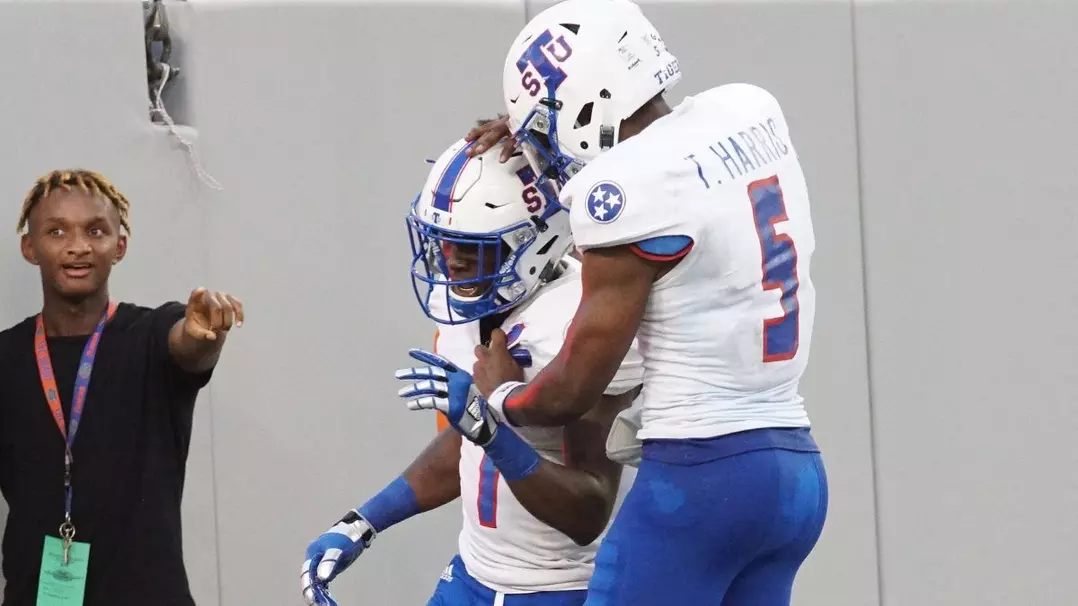
TSU will play its second straight home game on October 21 as they will welcome longtime rival and former Atlanta Classic foe, Florida A&M, to Nashville. Tennessee State holds a 31-24 all-time series edge, winning its last matchup 24-17 in the Tampa Classic, played September 16, 2017.
How it might go:
The Rattlers renew football pleasantries in what will be a physical, back-and-forth slugfest. The battle-tested Rattlers still have enough holdovers from last season’s championship team that will allow FAMU to play with poise down the stretch of this matchup. The same cannot be said for Tennessee State, while improved from a season ago, but the growing pains of inexperience will prove their undoing, as blunders in key moments will allow Florida A&M to depart the 615 with a 31-21 victory.
Week 9 – October 24
TSU vs. Grambling State
Nissan Stadium
Nashville, Tennessee
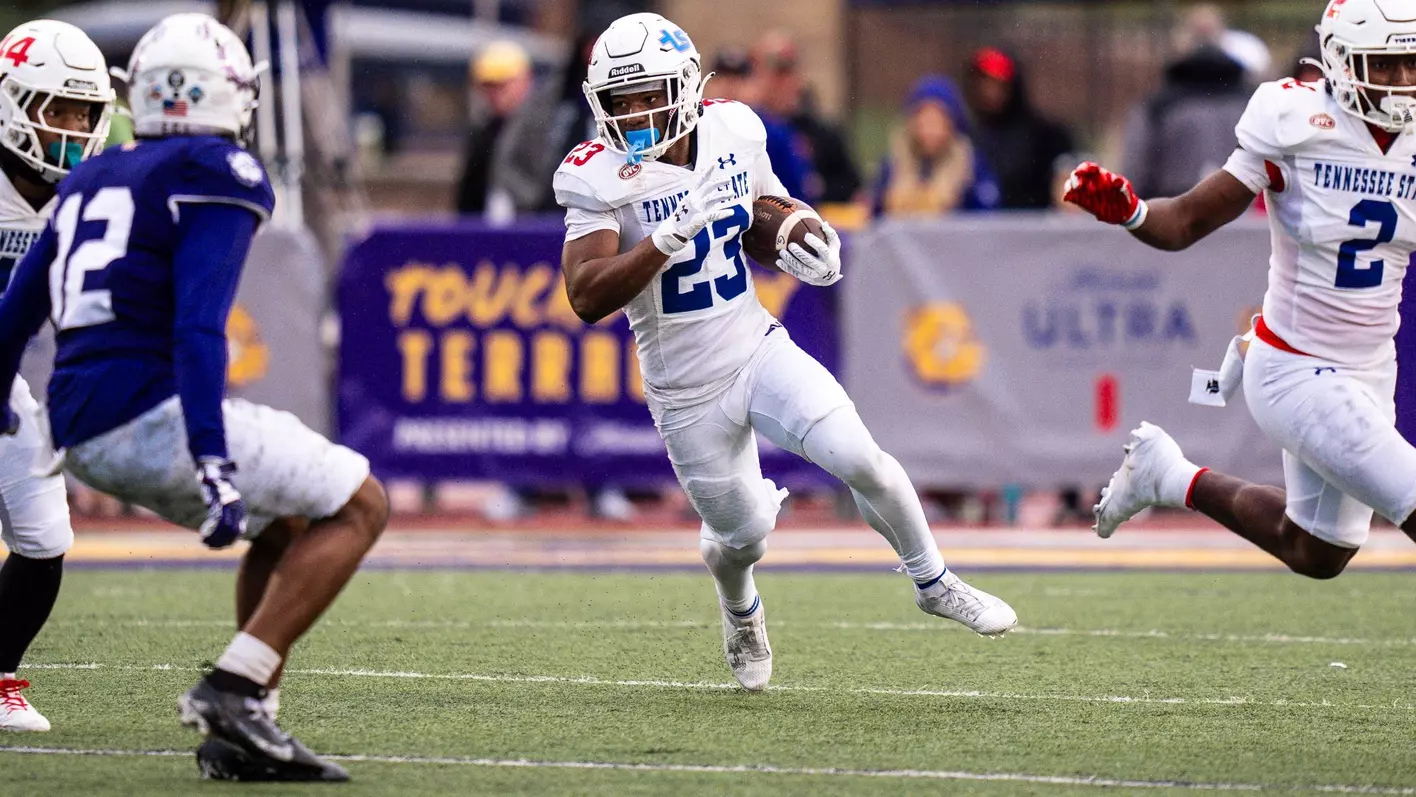
Week nine will mark TSU’s second straight home game as they are set to continue to SWAC play as they will host western division opponent Grambling State for a later than normal homecoming. The two teams last faced off in the 2019 Black College Football Hall of Fame Classic in Canton, OH, where Grambling defeated Tennessee State 16-10 in a defensive battle. Grambling holds the all-time series edge, 20-22-1.
How it might go:
Grambling will be their worst enemy on this, turning the ball over four times on the afternoon, with half of them being unforced. One coming on a botched center-quarterback exchange and the other one occurring when the quarterback and running back were both on the same page on a handoff. Tennessee State took advantage of the gifts, turning them into 21 points.
Grambling was unable to overcome the three-touchdown handicap and Tennessee State would cruise to a comfortable 35-13 win.
Week 10 – October 31
TSU at Bethune-Cookman
Daytona Stadium
Daytona, Florida
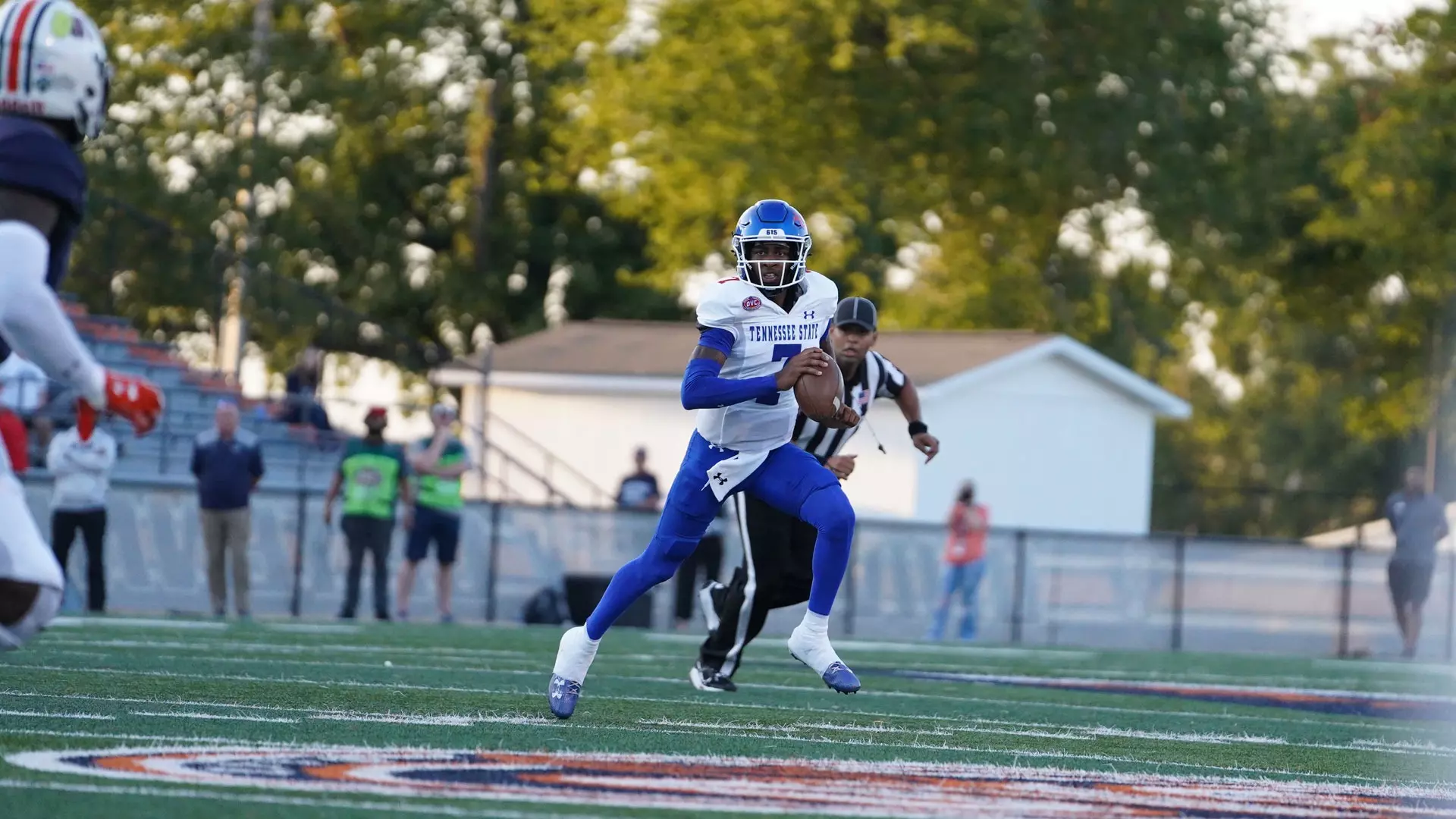
The Tigers will face their sixth SWAC opponent of the season on November 4, as they are set to head to Daytona, Fla., to take on Bethune-Cookman. The Wildcats and the Tigers last squared off on October 8, 2022, when Tennessee State hosted B-CU as their homecoming opponent and thrashed the Wildcats 41-17.
How it might happen:
Tennessee State’s physical style will overwhelm a game, but overmatched Bethune-Cookman team. TSU will follow its game plan of physical play in the trenches to get its run game, which will open the Tigers’ passing game, as Tennessee State will defeat the Wildcats 28-12.
Week 11 – November 7
TSU at Alabama State
Hornet Stadium
Montgomery, Alabama
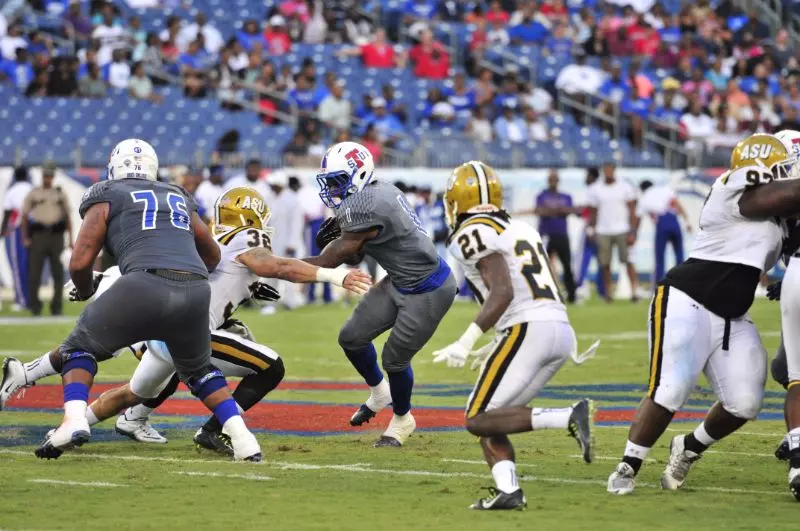
This will be the first meeting between the Hornets and Tigers since Alabama State was opposite Tennessee State on September 6, 2015, in the John Merritt Classic, a game that TSU won 24-14. Tennessee State holds an 11-3 all-time edge against Alabama State.
How it might go:
In a physical, hard-hitting, pad-popping matchup, Alabama State quarterback Andrew Body would prove to be different. The body presented problems the Tennessee State defense could not solve, making plays with his arm, but also his legs as he was able to break containment on multiple occasions allowing the Hornets to extend key drives. Alabama State defends their house, defeating the Tigers 27-17.
Week 12 – November 14
TSU at Jackson State
Veterans Memorial Stadium
Jackson, Mississippi
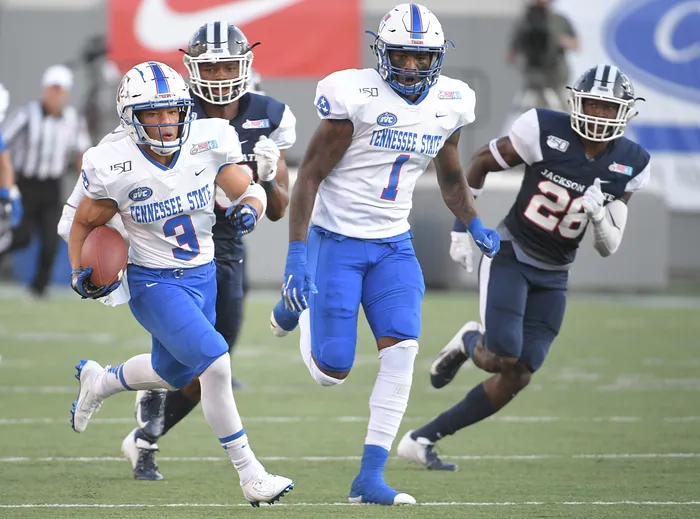
TSU will head to Jackson to take on Jackson State, their former rival of the Southern Heritage Classic. The last time these two teams got it on, which was in the 33rd Southern Heritage Classic, a 16-3 win for Jackson State, although the score belies how hard-fought and competitive the matchup was. Prior to their time in the SHC the two teams engaged in an alternating home-and-home series that took place from 1975-89. Jackson State last visited Nashville September 10, 1988, taking on TSU and playing to a 26-26 tie, while Tennessee State’s last trip to Jackson was on September 9, 1989, resulting in a 33-7 shellacking from JSU. In the most recent iteration of the rivalry, Tennessee State has tasted defeat in their last three meetings, not defeating Jackson State since winning a 17-15 nail-biter in the 2017 Southern Heritage Classic.
How it might happen:
Although the cast of characters has changed, these are two programs that are quite familiar with one another. In what will be a hard-hitting, pad-popping 60 minutes of gridiron action, II will be Tennessee State will make critical plays down the stretch on a pivotal drive that produced the go-ahead points late in the game. Though battered and bruised, Tennessee State will leave Veteran’s Memorial with a hard-fought and well-earned 21-17 win.
Week 13 – November 21
TSU vs. Alabama A&M
Legacy Series Classic
Nissan Stadium
Huntsville, Alabama
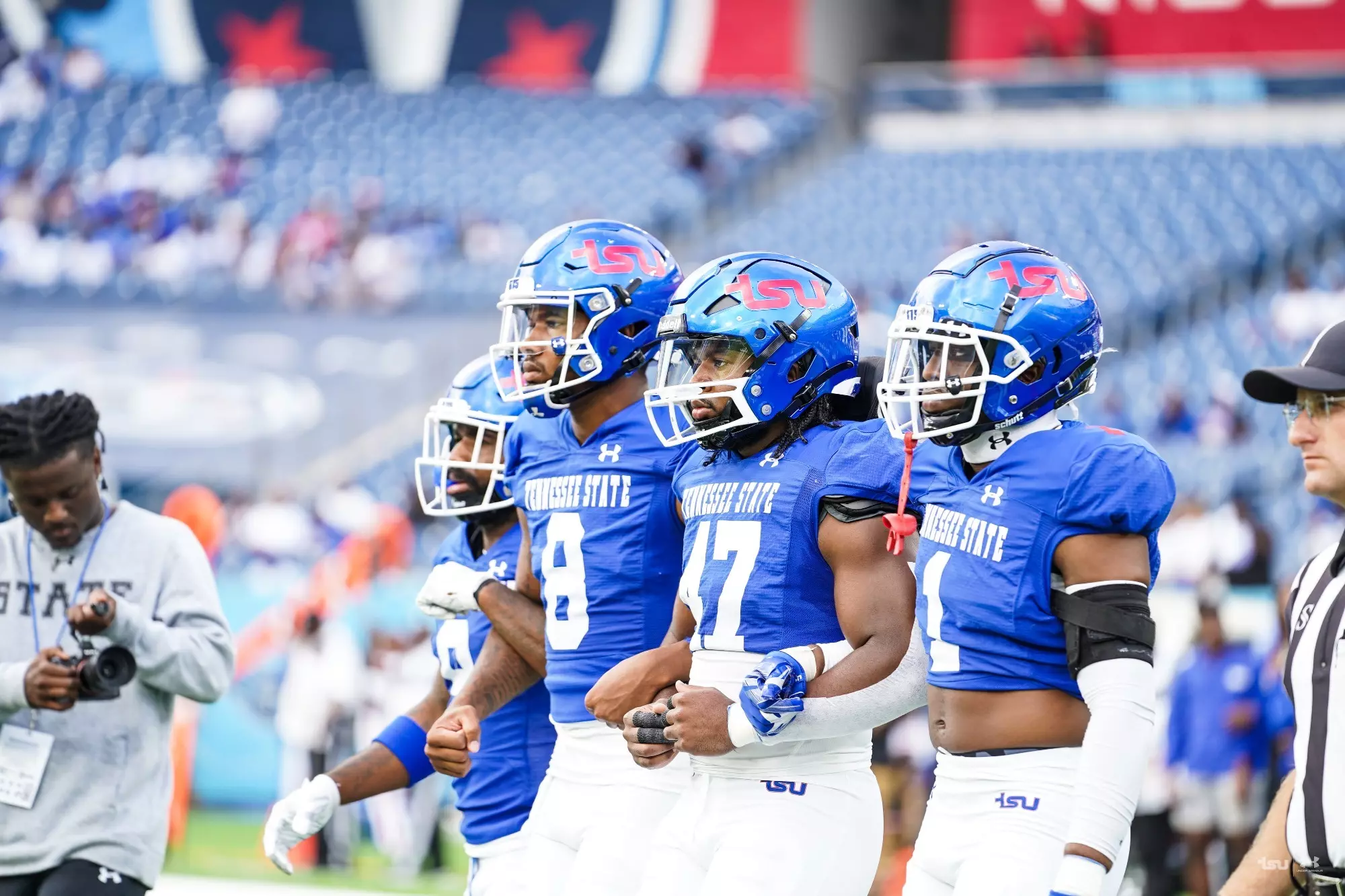
The Bulldogs are coming off a losing season and renewing a recently established rivalry. With this as a conference game, it does not require the previously required contractual payout of $100K to a visiting opponent to this matchup. The two teams have met 29 times, with Tennessee State winning 21 of those contests, including their last 27-14, September 4, 2010.
How it might go:
Alabama A&M is still looking to fill an Aqeel Glass-sized hole at the quarterback position and that issue still will not have been solved by the time they hit the field in Nashville. Falling behind early, AAMU quarterbacks will consistently be unable to make the required throws to push the football down the field. The Tigers will be able to use their run game away to turn the clock into an additional opponent for the Bulldogs, leaving them without vital time and opportunity to mount a comeback. Tennessee State gets a win, 29-13.
Week 14 – November 29
Open
Week 15 – December 5
SWAC Championship Game
TBA
Week 16 – December 12
Cricket Celebration Bowl
Mercedes Benz Stadium
Atlanta, Georgia
Final record: 9-3
Final SWAC record: 7-2

Tennessee State’s first season in the SWAC was a successful campaign finished at 9-3 overall, 7-2 in conference play and would be one of the top teams in the SWAC’s Western (Eastern) Division. The Tigers win the Eastern Division in SWAC inaugural season as they win the head-to-head tie breaker of their rival Jackson State and will host the Southern Jaguars winners of the Western Division for the right to go to Atlanta for the Cricket Celebration Bowl. It was also announced by John Grant, Executive Director of Cricket Celebration Bowl, that Tennessee State Tigers will face the Morgan State Bears in the 2030 Cricket MEAC SWAC Challenge Kickoff. The TSU fanbase, finally with the opportunity to watch HBCU competition every week responded by coming out in droves, as the Tigers averaged 19,035 fans per game, which was the third most in the SWAC behind Jackson State and Alabama State and was the fifth highest in all of FCS.

